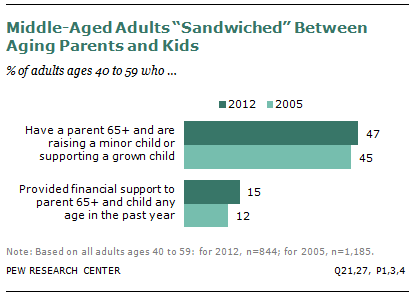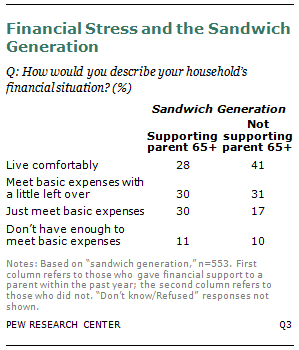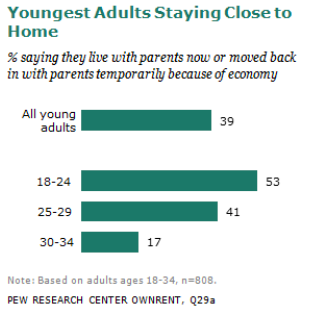136 Midlife Relationships
Martha Lally and Suzanne Valentine-French
The sandwich generation refers to adults who have at least one parent aged sixty-five or older and are either raising their own children or providing support for their grown children. According to a recent Pew Research survey, 47 percent of middle-aged adults are part of this sandwich generation (Parker and Patten, 2013). In addition, 15 percent of middle-aged adults are providing financial support to an older parent while raising or supporting their own children (see Figure 8.29). According to the same survey, almost half (48 percent) of middle-aged adults have supported their adult children in the past year, and 27 percent are the primary source of support for their grown children.

Seventy-one percent of the sandwich generation is age forty to fifty-nine, 19 percent is younger than forty, and 10 percent are sixty or older. Hispanics are more likely to find themselves supporting two generations; 31 percent have parents sixty-five or older and a dependent child, compared with 24 percent of white and 21 percent of Black adults (Parker and Patten, 2013). Women are more likely to take on the role of care-provider for older parents in the US and Germany (Pew Research, 2015). About 1 in 5 women say they have helped with the personal care, such as getting dressed or bathing, of aging parents in the past year, compared with 8 percent of men in the US and 4 percent in Germany. In contrast, in Italy, men are just as likely (25 percent) as women (26 percent) to have provided personal care.
The Pew survey found that almost 1 in 3 of sandwich-generation adults were more likely to say they always feel rushed, while only 23 percent of other adults said this. However, the survey suggests that those who were supporting both parents and children reported being just as happy as those middle-aged adults who did not find themselves in the sandwich generation (Parker and Patten, 2013). Adults who are supporting both parents and children did report greater financial strain (see Figure 8.30). Only 28 percent reported that they were living comfortably versus 41 percent of those who were not also supporting their parents. Almost one third were just making ends meet, compared with 17 percent of those who did not have the additional financial burden of aging parents.

Kinkeeping: At midlife adults may find themselves as a kinkeeper. In all families there is a person or persons who keep the family connected and who promote solidarity and continuity in the family (Brown and DeRycke, 2010). Who in your own family do you count on to organize family gatherings? Who knows the history of your family? Who do people turn to in your family for advice and support? Who works to strengthen the bonds between members of your family? These are your family’s kinkeepers, and they are usually women (Leach and Braithwaite, 1996; Brown and DeRycke, 2010). Leach and Braithwaite found that 86 percent of their respondents named a woman as their family’s kinkeeper, and Brown and DeRycke found that mothers, maternal grandmothers, and paternal grandmothers were more likely to be a family’s kinkeeper than were fathers, young adult children, and grandfathers combined. Brown and DeRycke also found that among young adults, women were more likely to be a kinkeeper than were young adult men.
Kinkeeping can be a source of distress when it interferes with other obligations (Gerstel and Gallagher, 1993). Gerstel and Gallagher found that, on average, kinkeepers provide almost a full week of work each month to kinkeeping (almost thirty-four hours). They also found that the more activities the kinkeeper took on, and the more kin they helped, the more stress and higher the levels of depression a kinkeeper experienced. However, unlike other studies on kinkeeping, Gerstel and Gallagher also included a number of activities that would be considered more “caregiving,” such as providing transportation, making repairs, and providing meals in addition to the usual activities of kinkeeping.
Empty nest: The empty nest, or post-parental period (Dennerstein, Dudley, and Guthrie, 2002), refers to the time period when children are grown up and have left home. For most parents this occurs during midlife. This time is recognized as a “normative event” as parents are aware that their children will become adults and eventually leave home (Mitchell and Lovegreen, 2009). The empty nest creates complex emotions, both positive and negative, for many parents. Some theorists suggest this is a time of role loss for parents, others suggest it is one of role strain relief (Bouchard, 2013).
The role-loss hypothesis predicts that when people lose an important role in their life they experience a decrease in emotional well-being. It is from this perspective that the concept of the empty nest syndrome emerged, which refers to great emotional distress experienced by parents, typically mothers, after children have left home. The empty nest syndrome is linked to the absence of alternative roles for the parent in which they could establish their identity (Borland, 1982). In Bouchard’s (2013) review of the research, she found that few parents reported loneliness or a big sense of loss once all their children had left home.
In contrast, the role-strain-relief hypothesis suggests that the empty nest period should lead to more positive changes for parents, as the responsibility of raising children has been lifted. The role-strain-relief hypothesis was supported by many studies in Bouchard’s (2013) review. A consistent finding throughout the research literature is that raising children has a negative impact on the quality of martial relationships (Ahlborg, Misvaer, and Möller, 2009; Bouchard, 2013). Several studies have reported that marital satisfaction often increases during the launching phase of the empty nest period, and that this satisfaction endures long after the last child has left home (Gorchoff, John, and Helson, 2008).
However, most of the research on the post-parental period has been with American parents. A number of studies in China suggest that empty-nesters, especially in more rural areas of China, report greater loneliness and depression than their counterparts with children still at home (Wu et al., 2010). Family support for the elderly by their children is a cherished Chinese tradition (Wong and Leung, 2012). With children moving from rural communities to larger cities for education and employment, this may explain the more pessimistic reaction of Chinese parents than in American samples. The loss of an adult child in a rural region may mean a loss of family income for aging parents. Empty-nesters in urban regions of China did not report the same degree of distress (Su et al., 2012), suggesting that it not so much the event of children leaving, but the additional hardships this may place on aging parents.
Boomerang kids: As you read in chapter seven, young adults are living with their parents for a longer duration and in greater numbers than previous generations. In addition to those in early adulthood who are not leaving the home of their parents, there are also young adults who are returning after having lived independently outside the home, and these are called boomerang kids.

Figure 8.31 shows the number of young people who are still living at home (Parker, 2012). In addition, 63 percent of 18- to 34-year-olds know someone who has returned to live with their parents. Many of the same financial reasons that are influencing young people’s decisions to delay exit from the home of their parents are underlying their decisions to return home. In addition to financial reasons, some boomerang kids are returning because of emotional distress, such as mental health issues (Sandberg-Thoma, Snyder, and Jang, 2015).
What is the effect on parents when their adult children return home? Certainly there is considerable research that shows that the stress of raising children can have a negative impact on parents’ well-being, and that when children leave home many couples experience less stress and greater life satisfaction (see the section on the empty nest). Early research in the 1980s and 1990s supported the notion that boomerang kids, along with those who were failing to exit the home, placed greater financial hardship on the parents, and the parents reported more negative perceptions of this living arrangement (Aquilino, 1991). Recent surveys suggest that today’s parents are more tolerant of this, perhaps because this is becoming a more normative experience than in the past. Moreover, children who return are more likely to have had good relationships with their parents growing up, so there may be less stress between parents and their adult children who return (Sandberg-Thoma et al., 2015). Parents of young adults who have moved back home because of economic reasons report that they are just as satisfied with their life as are parents whose adult children are still living independently (Parker, 2012). Parker found that adult children age twenty-five and older are more likely to contribute financially to the family or complete chores and other household duties. Parker also found that living in a multigenerational household may be an economic safety net for young adults. In comparison to young adults who were living outside of the home, those living with their parents were less likely to be living in poverty (17 percent versus 10 percent).
So far we have considered the impact that adult children who have returned home or have yet to leave the nest have on the lives of middle-aged parents. What about the effect on parents who have adult children dealing with personal problems, such as alcoholism, chronic health concerns, mental health issues, trouble with the law, poor social relationships, or academic or job-related problems, even if they are not living at home? The life course perspective proposes the idea of linked lives (Greenfield and Marks, 2006). The notion that people in important relationships, such as children and parents, mutually influence each other’s developmental pathways. In previous chapters you have read about the effects that parents have on their children’s development, but this relationship is bidirectional. The problems faced by children, even when those children are adults, influence the lives of their parents. Greenfield and Marks found in their study of middle-aged parents and their adult children, those parents whose children were dealing with personal problems reported more negative affect, lower self-acceptance, poorer parent–child interactions, and more family relationship stress. The more problems the adult children were facing, the worse the lives and emotional health of their parents, with single parents faring the worst.
Media Attributions
- Figure 8 29 © Pew Research Center is licensed under a Public Domain license
- Figure 8 30 © Pew Research Center is licensed under a Public Domain license

